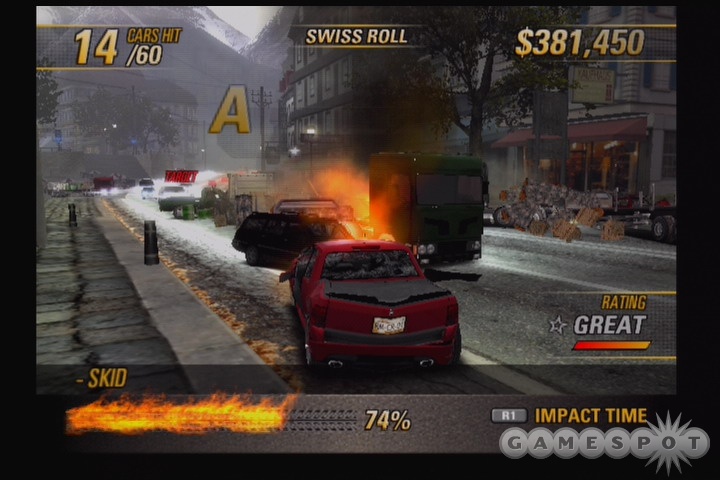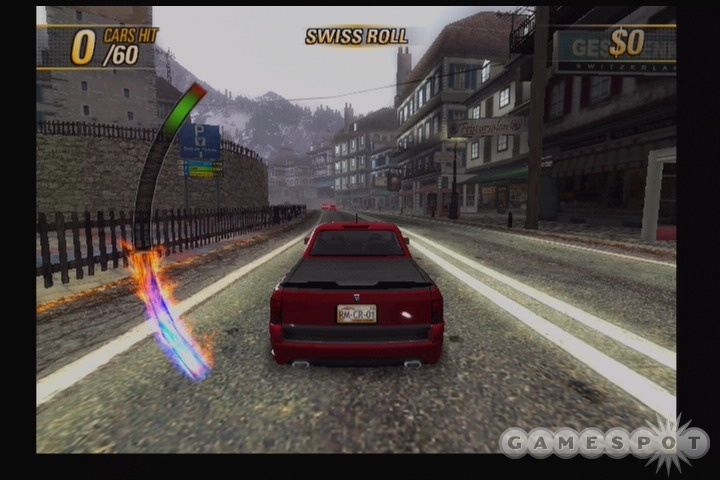Burnout Revenge Crash Mode Preview
When does twisted metal and burned rubber remind you of a golf game? When it's Burnout Revenge. We investigate crash mode in our hands-on look.
Burnout Revenge is currently barreling its way toward a mid-September release, and the game is ready to deliver even more of the kind of fiery, metal-torturing fun found in last year's Burnout 3: Takedown, with some important new twists thrown into the mix. One such twist is the updated crash mode, which is receiving a big-time makeover this time around. We've had some time to spend with this upgraded mode, and the results are nastier (in a good way) than a 50-car pileup on the New Jersey Turnpike.

Burnout Revenge producers told us that the Criterion development team took a new approach to Revenge's crash mode, pulling much of their inspiration from the gentlemanly sport of golf, of all things. Indeed, many of the peripheral aspects of crash mode have a links-esque flair. Launching your car off the line, for instance, is no longer simply a matter of pressing the gas and pointing your car into traffic. Instead, you'll have an all-new launch meter that behaves a lot like the three-mouse-click swing meter in older PC golf games. Pressing the button initiates the meter, a second button press stops the vertical meter at the top, and a final press stops it at the bottom.
Your goal, in most cases, will be to stop the meter at both ends in the green zones, to achieve a maximum-speed straight shot. Should you end up missing the green zone, you might miss a turbo boost and creep off the line, or your car may suddenly veer to the right or left--the Burnout Revenge equivalent of a slice or hook. It doesn't stop there, however. If you manage to stop the meter at the very top red zone, your car will explode then and there, a surefire way to minimize highway mayhem before it even starts. Stop it at the very bottom of the meter and your car will stall, which means you might miss a valuable early bus or two to smash into.
Just as there are multiple ways to attack a golf course, the crash mode courses in Burnout Revenge provide a number of different ways to find explosive success. For starters, they're huge--even the starting crash mode courses seem larger and more expansive than those found in Burnout 3. Many comprise multiple levels that, if you can manage to reach them, can extend your destruction derbies for far longer than you've been able to in the past.
Consider this description of the aptly named Cars Attacks course, for instance. The course begins on the upper lane of a towering urban freeway teeming with traffic. As you shoot off the line, you have a couple of immediate choices: You can take the "high" road and barrel through traffic, in the hopes of creating the most freeway mayhem possible; or you can take the "low" road and careen off a handy ramp that leads directly into a parking lot some three or four stories below, packed with even more cars just waiting to be turned into scrap. You can even go for a best-of-both-worlds approach: tie up traffic on the upper freeway and use a well-timed crashbreaker to bounce your car off the ledge and down into the parking lot. Just as in golf, each time you attack the course can be an entirely new experience.

In keeping with this new, open-ended approach, a couple of key elements to crash mode in Burnout 3 have been removed: the old scoring system and scoring modifiers. Unlike in last year's game, which utilized a complex formula of degree of damage coupled with car type, every car in Revenge will have a set value that you earn, no matter if it suffers a mere scratch or is totaled. Furthermore, score modifiers--a mainstay of Burnout 3--are gone in Revenge. The development team felt that Burnout 3 players were too intent on reaching those valuable "4x" modifiers as the only possible way to complete a crash mode course. Now that the score bonuses are gone, players will be more apt to try a number of different paths toward achieving those much-sought-after gold medals.
Golfing With Autos
Just how far can the analogy between golf and Burnout Revenge's crash mode be extended? Well, it's probably no coincidence that each course has a small flag indicating wind speed and direction, an attribute that can have significant impact on the flight path of your airborne burning wreck. And considering that each car you use in the game has different speed and acceleration attributes, it seems fair to consider each available car as golf clubs in your bag. You'll need to choose the right car for each course--some will require a bit more toughness in order to survive until you reach the prime crash-breaking real estate.

You'll be able to use the new-for-Revenge traffic checking on your way to the end of a crash mode course, in an attempt to cause as much chaos as possible. Traffic checking only works on cars heading in the same direction as you, but, if used correctly, this can be a great tool in your arsenal for racking up points. Other car models will rely on nothing but speed to garner maximum air and maximum carnage. The choice is up to you, though some courses will restrict the number of car options you have to choose from, which puts a bigger emphasis on nailing a perfect start off the line.
Crashbreakers return in Burnout Revenge, but in crash mode, they are executed in a slightly different manner. As traffic piles up on the streets, you'll be filling up a meter at the bottom of the screen. Once it's topped off, you'll have a brief window to charge up your crashbreaker by rapidly pressing a button on your controller. Obviously, the more crashbreaker power you build up, the more damage you'll cause, and the more points you'll rake in. With some careful planning, deft use of the aftertouch controls that let you guide your bashed-up car postcrash, and a little luck, you'll be able to pull off multiple crashbreakers in a single run. A fully controllable camera helps here, letting you swing your car around to get a great look at oncoming traffic as well as the havoc you've already caused.
The primal joy of destroying wholesale tonnage of automobiles is increased by Revenge's sharp-looking graphics. There's a slightly dirty tone to all the environments that really adds grit to all the destruction. The slight blurring effect that takes over when your car is suspended in midair and is heading directly for a tanker or passenger adds a great deal of suspense to each outing on the track. If there's one minor annoyance, it's the blurred rewind effect that happens after each track mode outing; it feels too much like a loading screen, and we'd be perfectly happy if we could skip it altogether.
Finally, it's important to note that Revenge's crash mode events are all tied in to the main single-player game--they're not a completely unconnected game mode, as in the last game. As you complete crash mode challenges, you'll unlock new areas to drive in and new events (including other crash mode courses) to lay waste to. You'll also be upping your overall revenge meter, which is tied directly to the amount of progress you've made in the game and to the level of aggression you've shown while hitting the tarmac (and everything else in sight).
As with nearly every aspect of Revenge, the crash mode in this year's game looks to be significantly improved over Burnout 3. Will all the game's elements cohere into one whole, as they did last year? We'll get to answer that question definitively when Burnout Revenge ships on the PS2 and Xbox in September. Stay tuned for more.
Got a news tip or want to contact us directly? Email news@gamespot.com

Join the conversation